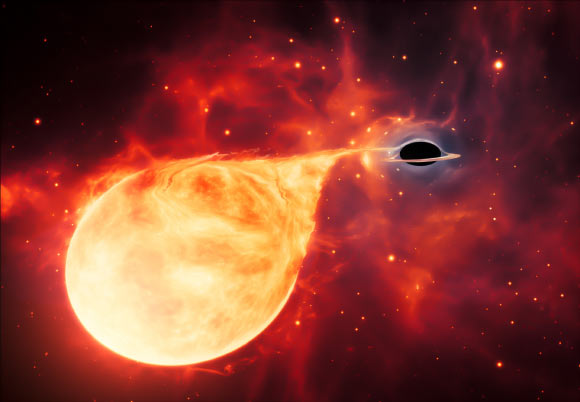A bright X-ray source in a massive star cluster in the outskirts of 6dFGS gJ215022.2-055059, a barred lenticular galaxy located about 806 million light-years away from Earth, is an intermediate-mass black hole, according to a new study published in the Astrophysical Journal Letters.
Source: Sci News
Astronomers know that black holes ranging from about 10 times to 100 times the Sun’s mass are the remnants of dying stars, and that supermassive black holes, more than 100,000 times the mass of the Sun, inhabit the centers of most galaxies.
But scattered across the Universe are a few apparent black holes of a more mysterious type.
Ranging from 100 to 100,000 solar masses, these intermediate-mass black holes are very elusive objects, and so it is critical to carefully consider and rule out alternative explanations for each candidate.
“That is what Hubble has allowed us to do for our candidate,” said lead author Dr. Dacheng Lin, an astronomer at the University of New Hampshire.
In 2006, NASA’s Chandra X-ray Observatory and ESA’s XMM-Newton spacecraft detected a powerful flare of X-rays, but it was not clear if they originated from inside or outside of our Milky Way Galaxy.
Astronomers attributed it to a star being torn apart after coming too close to a gravitationally powerful compact object, like a black hole.
Surprisingly, the X-ray source, named 3XMM J215022.4-055108, was not located in the center of a galaxy, where massive black holes normally reside.
This raised hopes that an intermediate-mass black hole was the culprit, but first another possible source of the X-ray flare had to be ruled out: a neutron star in the Milky Way, cooling off after being heated to a very high temperature.

The NASA/ESA Hubble Space Telescope was pointed at the X-ray source to resolve its precise location.
Deep, high-resolution imaging confirmed that the X-rays emanated not from an isolated source in the Milky Way, but instead in a distant, dense star cluster in the outskirts of 6dFGS gJ215022.2-055059 — just the sort of place astronomers expected to find evidence for an intermediate-mass black hole.
The star cluster that is home to 3XMM J215022.4-055108 may be the stripped-down core of a lower-mass dwarf galaxy that has been gravitationally and tidally disrupted by its close interactions with its current larger galaxy host.
Dr. Lin and colleagues also combed through the XMM-Newton data archive, searching hundreds of thousands of sources to find strong evidence for this one candidate.
Once found, the X-ray glow from the shredded star allowed the astronomers to estimate the black hole’s mass — about 50,000 times that of the Sun.
“Studying the origin and evolution of the intermediate mass black holes will finally give an answer as to how the supermassive black holes that we find in the centers of massive galaxies came to exist,” said co-author Dr. Natalie Webb, an astronomer at the Université de Toulouse.
Source: Sci News

































Leave a Comment
You must be logged in to post a comment.